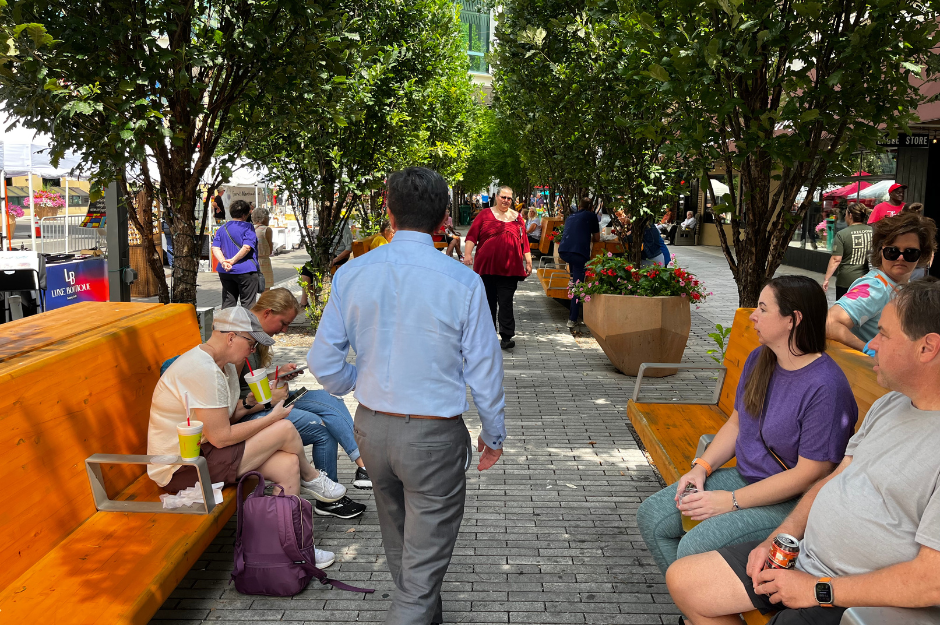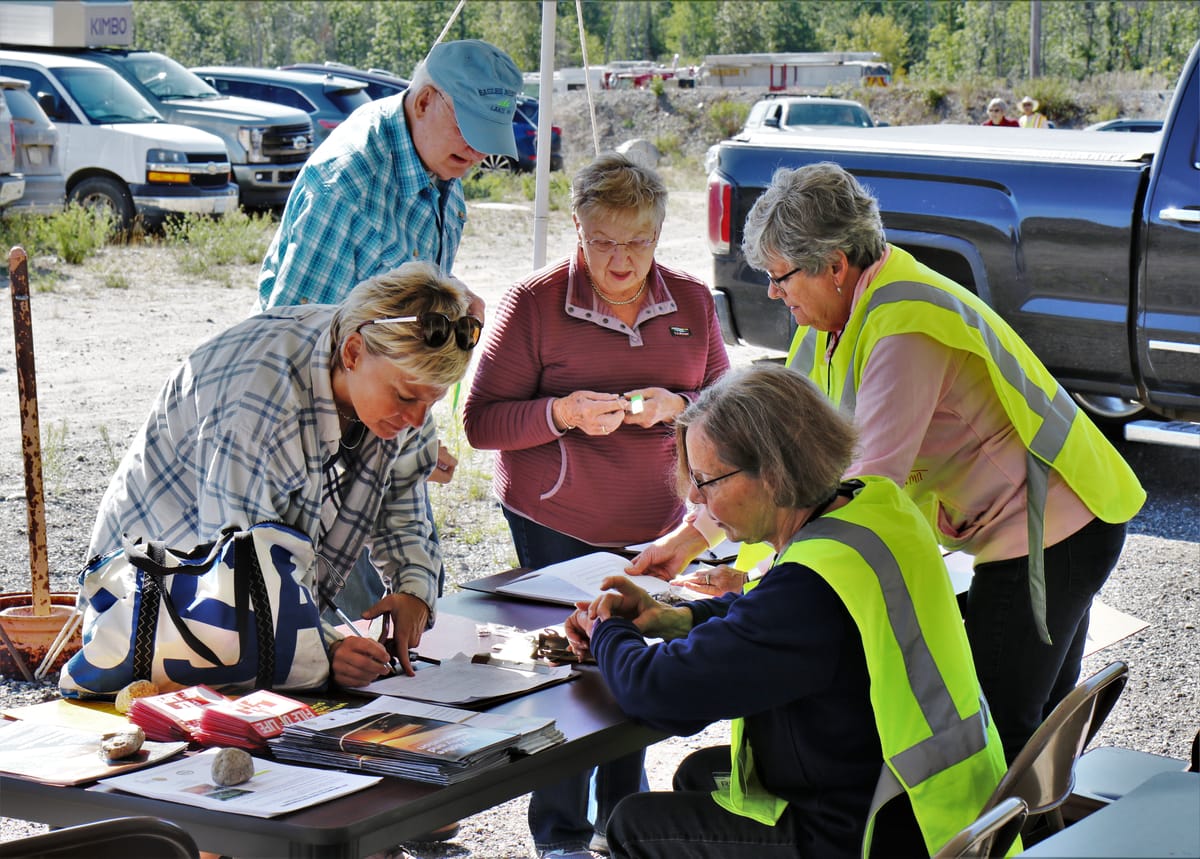Community Voices ⎸ Looking for a thriving, post-COVID downtown? Head to Rochester
Mayo Clinic and the Destination Medical Center have helped make the “orchestrated serendipity” possible, writes Bill Lindeke of MinnPost.

by Bill Lindeke
MinnPost
This story was originally published by MinnPost on August 5, 2024. Find the original story here.
Whenever I yearn to return to a bustling pre-COVID city, with a thriving downtown headed in the right direction, I know just what to do. Head 75 miles southeast to downtown Rochester, and the sidewalks come alive with people. Downtown Rochester is looking better than ever, thanks to a booming economy driven by the Mayo Clinic and large subsidies for downtown infrastructure.
The key ingredient in Rochester’s secret sauce is no real mystery. It’s home to the massive, world-famous Mayo Clinic headquarters, which employs the majority of downtown workers. The blue-and-green iconography almost makes the downtown feel almost like a corporate campus, albeit a very urban one.
“It’s hard to get your head around the impact [of the] Mayo Clinic, and it has said that it wants to grow its global headquarters here,” said Patrick Seeb, the executive director of Rochester’s Destination Medical Center (DMC), the office coordinating public investment. "What we’re asking is that the city keep up with us, that the city keep pace."

One major thing making Rochester unique is the “work from home” situation, where the trend that has destabilized other downtowns has left Rochester mostly unscathed. As Seeb explains, of the 40,000 Mayo workers downtown, around three-quarters of those jobs require their physical presence at the many hospitals, clinics, and research centers. This means Rochester’s largest downtown population hasn’t disappeared, as they have in Minneapolis and St. Paul. You’ll still find actual lunch counters and clothing stores in the downtown skyways, still open for business. To me, that counts as a minor miracle.
The other big variable separating Rochester from other downtowns is money. In 2013, state and local governments set aside $585 million to be spent on downtown Rochester’s public infrastructure, a massive amount to leverage under the DMC umbrella. Twelve years later, that’s meant lots of shiny, public-realm investments: whole new streets, sidewalks, parks, plazas, public art, and more.
The difference is apparent, and Rochester’s downtown core is gleaming and transformed since the last time I visited. Most noteworthy are the new streets boasting a rich bounty of sidewalk amenities like quality benches, trees, sculptures, restored buildings, and programmed activities.
“The walkability experience is really important, and we’re giving it a lot of attention,” Seeb said. “We know a lot of people get to downtown by automobile, but once they get here they still have to walk, they still have to get from the parking ramp and walk to the hotels and dense housing.”
Seeb’s key strategy is something familiar to readers of downtown revitalization plans: The DMC has focused intensely on improving the “public realm,” making the streets much more walkable and welcoming for pedestrians.
In Rochester, that’s meant complete reconstruction of downtown’s main streets like 2nd Avenue and (former) 1st Street in the heart of the city. Gone are the multiple lanes of traffic and on-street parking, replaced with curbless sidewalks perfect for the occasional street fair (held weekly throughout the summer) or even fully vacated pedestrian spaces.
“A lot of what you’ll see is the community space, both indoor and outdoor, to bring people together,” said Seeb, who calls the result a form of “orchestrated serendipity.”
This transformation is made difficult by the ubiquitous Minnesotan “skyway problem,” where downtown skyways segregate economic activity and public space. In Rochester, the disconnect is arguably worse because they have both a “skyway” and a “subway” under the street level between core buildings. That makes DMC’s street-level work even more impressive, luring people out of the climate-controlled hallways.

Each Thursday, Rochester’s downtown core turns into a busy craft market and public concert space, with a host of food vendors.
As with most downtowns these days, Seeb admits that they probably have enough parking, with the recent completion of another ramp on downtown’s west edge. Instead, almost all of the attention seems to be on creating lively, comfortable sidewalks, though Seeb admits that the tactile poetry along the central Peace Plaza may have gone too far (literally). For future projects, DMC has committed to prioritizing ADA-accessible space for future street reconstruction projects like the one along 2nd Avenue.
In a sense, Rochester’s new streets remind me of what the 2017 Nicollet Mall remodel was supposed to accomplish, intended to bring street life, public art, and event flexibility into the heart of downtown Minneapolis. For a complex set of reasons, the formula seems to have worked out better here than in downtown Minneapolis, probably because of Rochester’s greater ability to shape nearly every facet of the built environment.
A highway-free downtown
Compared to St. Paul or Minneapolis, downtown Rochester has two more coincidental geographic benefits. For one thing, there’s no massive highway ringing its downtown core. Highway 52 runs a mile away to the west, and as a result, walking in and out of the downtown is seamless and pleasant. It’s a far cry from the bleak freeway trenches that form moats around Minneapolis, St. Paul, or Duluth.
The riverfront is likewise unburdened by any meaningful industrial legacy, so that the banks of the Zumbro, curving through downtown, are easily accessible to wanderers. A new bridge planned for 6th Street aims to make the riverbanks even more connected with the downtown, and better integrate the large Soldier’s Field park into the downtown core.
The way the Rochester’s city plan works, the downtown has a half dozen or so small “subdistricts,” and DMC intends to build signature park space in each one. As you’d expect from what sometimes feels like a company town, they all have their own names and brand identities. For example, there’s “Heart of the City” at the center, or fast-growing “Discovery Square.” In practice, those distinctions fade away, and Rochester just seems like a nice, coherent place where everyone has a matching lanyard.

In addition to improving the urban experience for Mayo workers and visitors, the other main goal for Patrick Seeb and DMC is to attract investment capital. That’s where the plans start to become more aspirational, especially given the small population of the Rochester metro area. The slogan above the DMC office, "America’s City for Health,” remains a bit of a stretch.
"The density of smart people you’ll see on your day to day far exceeds San Diego Boston,” said Seeb, talking about the startup culture. “That’s part of our value proposition: If you’re a company that needs a certain talent or workforce, this whole idea of America’s city for health where great health care happens, where health care innovation happens, your brand goes farther because you came out of Rochester.”
Seeb points to startups working on prosthetics or wearable medical devices, and he seems to be continually pitching the business benefits of being in downtown Rochester, despite its small population.
For my money, the main missing ingredient remains a great intercity transportation connection to the Twin Cities and its airport. For example, if the stalled “Ziprail” plans had gone anywhere a decade ago, the idea of Rochester attracting national healthcare startups would be a lot more convincing.
Imagine if Rochester’s workforce could seamlessly commute back and forth to downtown Minneapolis a few days a week, or if patients could zip from the airport straight to the Mayo-adjacent hotel? Without that connection linking the Twin Cities economy to Rochester’s growth engine, the idea of competing for medical device investment with Boston or California seem a bit distant.
For the record, Seeb agrees that better links between Rochester and the Twin Cities are needed, though he’s likewise not a fan of the buzzy Hyperloop plan, calling it “vaporware.”

Even without a basic rail connection, Rochester is growing quickly. Last year, the Mayo Clinic announced it was spending $5 billion on a new medical complex expansion that would transform three city blocks along 2nd Street. The new buildings would be located directly alongside the new three-mile bus rapid transit line, planned to run from the east side of the Zumbro River in downtown all the way to Cascade Lake, west of Highway 52. The line will include electric vehicles and operate with free fares (subsidized by Mayo Clinic), and should accelerate the push for walkability downtown.
The general lesson here is that it’s amazing what a ton of money and tight-knit political will can do for a city. This is the kind of fast-paced investment — fresh concrete, public art, well-funded placemaking efforts — that downtown St. Paul can only dream about. Instead, these kinds of sweeping change seem almost pedestrian in downtown Rochester. Given the struggles of downtowns elsewhere, it’s a welcome salve.
This article first appeared on MinnPost and is republished here under a Creative Commons license.

